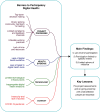Exploring the perspectives and practices of humanitarian actors towards the Participation Revolution in humanitarian digital health responses: a qualitative study
- PMID: 38671505
- PMCID: PMC11055264
- DOI: 10.1186/s12992-024-01042-y
Exploring the perspectives and practices of humanitarian actors towards the Participation Revolution in humanitarian digital health responses: a qualitative study
Abstract
Background: As crises escalate worldwide, there is an increasing demand for innovative solutions to enhance humanitarian outcomes. Within this landscape, digital health tools have emerged as promising solutions to tackle certain health challenges. The integration of digital health tools within the international humanitarian system provides an opportunity to reflect upon the system's paternalistic tendencies, driven largely by Global North organisations, that perpetuate existing inequities in the Global South, where the majority of crises occur. The Participation Revolution, a fundamental pillar of the Localisation Agenda, seeks to address these inequities by advocating for greater participation from crisis-affected people in response efforts. Despite being widely accepted as a best practice; a gap remains between the rhetoric and practice of participation in humanitarian response efforts. This study explores the extent and nature of participatory action within contemporary humanitarian digital health projects, highlighting participatory barriers and tensions and offering potential solutions to bridge the participation gap to enhance transformative change in humanitarian response efforts.
Methods: Sixteen qualitative interviews were conducted with humanitarian health practitioners and experts to retrospectively explored participatory practices within their digital health projects. The interviews were structured and analysed according to the Localisation Performance Measurement Framework's participation indicators and thematically, following the Framework Method. The study was guided by the COREQ checklist for quality reporting.
Results: Varied participatory formats, including focus groups and interviews, demonstrated modest progress towards participation indicators. However, the extent of influence and power held by crisis-affected people during participation remained limited in terms of breadth and depth. Participatory barriers emerged under four key themes: project processes, health evidence, technology infrastructure and the crisis context. Lessons for leveraging participatory digital health humanitarian interventions were conducting thorough pre-project assessments and maintaining engagement with crisis-affected populations throughout and after humanitarian action.
Conclusion: The emerging barriers were instrumental in shaping the limited participatory reality and have implications: Failing to engage crisis-affected people risks perpetuating inequalities and causing harm. To advance the Participation Revolution for humanitarian digital health response efforts, the major participatory barriers should be addressed to improve humanitarian efficiency and digital health efficacy and uphold the rights of crisis-affected people.
Keywords: Digital health; Health; Humanitarian; Inequity; LMIC; Localisation; Participation; Power.
© 2024. The Author(s).
Conflict of interest statement
The authors declare that they have no known competing interests, financial or otherwise and have no personal or professional relationships that could influence the reporting or interpretation of results from this research.
Figures
Similar articles
-
Localisation of digital health tools used by displaced populations in low and middle-income settings: a scoping review and critical analysis of the Participation Revolution.Confl Health. 2023 Apr 15;17(1):20. doi: 10.1186/s13031-023-00518-9. Confl Health. 2023. PMID: 37061703 Free PMC article.
-
Lessons from the COVID-19 pandemic to strengthen NCD care and policy in humanitarian settings: a mixed methods study exploring humanitarian actors' experiences.BMC Health Serv Res. 2024 Sep 17;24(1):1081. doi: 10.1186/s12913-024-11458-2. BMC Health Serv Res. 2024. PMID: 39289744 Free PMC article.
-
Key issues for participatory research in the design and implementation of humanitarian assistance: a scoping review.Glob Health Action. 2020 Dec 31;13(1):1826730. doi: 10.1080/16549716.2020.1826730. Glob Health Action. 2020. PMID: 33073736 Free PMC article.
-
Implementing Community-Based Participatory Research with Communities Affected by Humanitarian Crises: The Potential to Recalibrate Equity and Power in Vulnerable Contexts.Am J Community Psychol. 2020 Dec;66(3-4):381-391. doi: 10.1002/ajcp.12453. Epub 2020 Aug 14. Am J Community Psychol. 2020. PMID: 32797639
-
The sexual abuse of adolescent boys in humanitarian emergencies: A qualitative study of how international humanitarian organisations are responding.Child Abuse Negl. 2025 May;163:107327. doi: 10.1016/j.chiabu.2025.107327. Epub 2025 Feb 23. Child Abuse Negl. 2025. PMID: 39993348
References
-
- Vatikiotis M. Humanitarian crises in a multipolar world centre for humanitarian dialogue. 2022 [cited 2023. https://reliefweb.int/report/world/humanitarian-crises-multipolar-world
-
- The New Humanitarian. Why these 10 humanitarian crises demand your attention now aid and policy analysis. 2023 [cited 2023. https://www.thenewhumanitarian.org/analysis/2023/01/13/10-humanitarian-c...
-
- Global Humanitarian OCHA. Overview 2022 2022 [18 July 2022]. https://gho.unocha.org/delivering-better/local-actors-play-key-role-huma...
-
- WHO. WHO guideline: recommendations on digital interventions for health system strengthening Geneva: WHO; 2019 [cited 2023 December]. https://iris.who.int/bitstream/handle/10665/311941/9789241550505-eng.pdf... - PubMed
Publication types
MeSH terms
LinkOut - more resources
Full Text Sources
Research Materials
Miscellaneous


